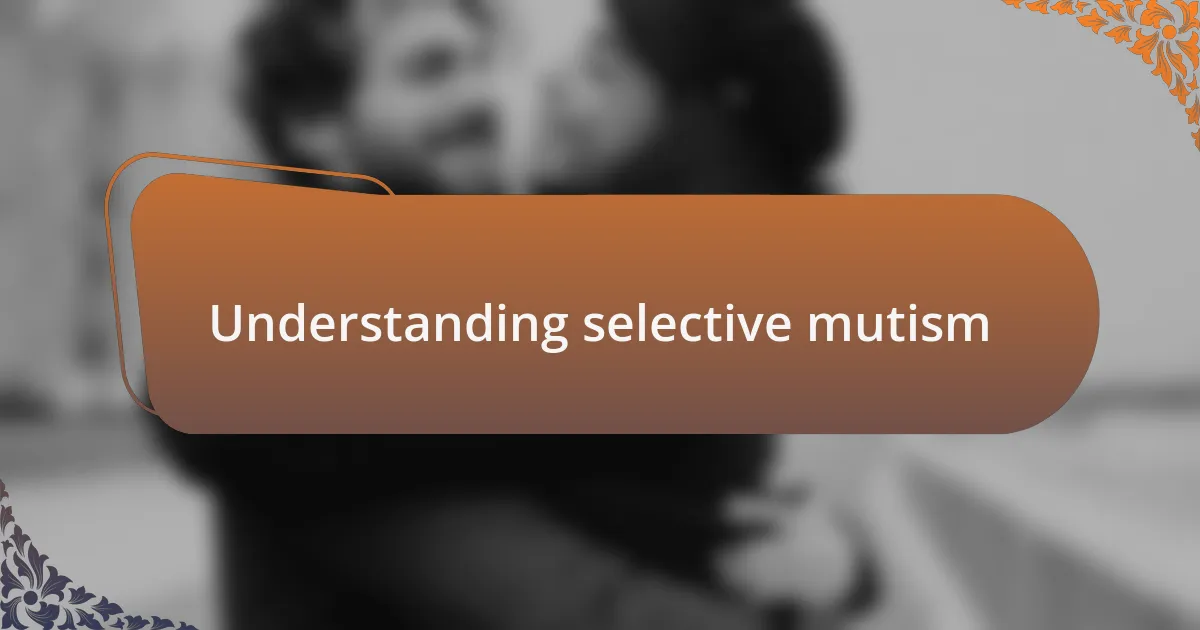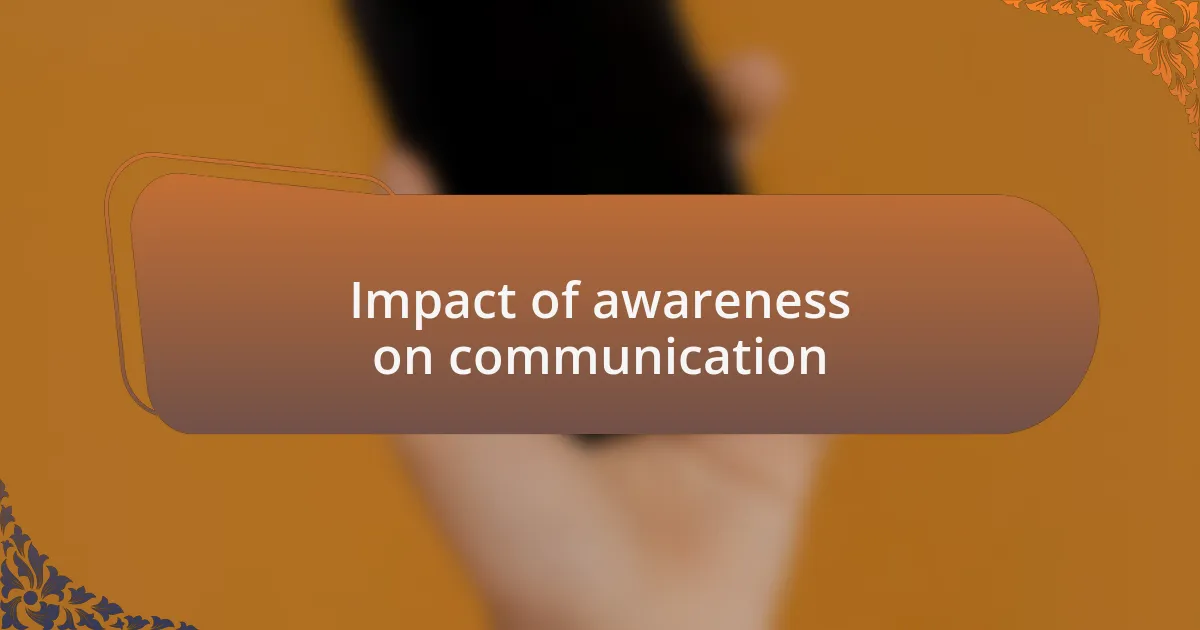Key takeaways:
- Selective mutism is an anxiety disorder affecting children’s ability to communicate in specific social situations, often misinterpreted as shyness or defiance.
- Early intervention and a supportive family environment are crucial for overcoming selective mutism, empowering children to find their voice.
- Building trust through gradual exposure and using visual aids can significantly enhance communication for children with selective mutism.
- Awareness of selective mutism and non-verbal cues can create more inclusive environments, promoting open and empathetic conversations.

Understanding selective mutism
Selective mutism is a complex anxiety disorder that primarily affects children, leading them to be unable to speak in certain social situations despite having the ability to communicate effectively in others. I remember a time when my friend’s child, normally so lively at home, would freeze in silence at school. It made me wonder: what fear grips these little ones so tightly that their voices vanish in public spaces?
While it’s easy to label selective mutism as shyness, the reality is far more intricate. I recall learning about how children with selective mutism are often struggling silently, trapped in a web of anxiety that few adults may recognize. It’s heartbreaking to think that many well-meaning individuals might misinterpret this behavior as mere stubbornness or defiance rather than a cry for understanding and support.
Understanding selective mutism requires diving deep into the social and emotional landscapes of these children. I often think about how empowering it could be if parents and teachers engaged them through gentle encouragement rather than pressure. How might it change their experience if we fostered environments where they felt safe to express themselves, even if it takes time?

Research insights on selective mutism
Research has shown that selective mutism often stems from an intense fear of social situations, rather than a simple reluctance to speak. I remember a workshop I attended that highlighted how a child’s brain can sometimes misinterpret social environments as threats. This revelation made me reflect on the importance of understanding the subtle signals a child sends, rather than dismissing their silence as mere shyness.
Studies indicate that early intervention is crucial for children with selective mutism. I once spoke with a speech therapist who shared incredible success stories of children gradually learning to communicate in stressful environments through structured support. It left me pondering: how many more children could break free from their silence if given the right tools and encouragement from a young age?
Moreover, research emphasizes the role of a supportive family environment in overcoming selective mutism. I vividly recall a parent sharing how small, daily interactions helped her child build confidence at home before facing the larger social world. This really brings to light the question of how we can create safe spaces for children to find their voice, as every supportive action can lead to monumental shifts in their journey.

Strategies for overcoming selective mutism
Building trust is one of the most effective strategies for overcoming selective mutism. In my experience, creating an environment where the individual feels safe to express themselves is crucial. I recall working with a young child and having them pick a favorite book. We started by simply reading together. Eventually, they began to whisper phrases from the story to me, and it was a breakthrough moment that illustrated how comfort could pave the way for communication.
Gradual exposure to social situations has also proven beneficial. I remember attending a community event where the organizers included activities designed for quiet children. These activities encouraged participation without pressure. I saw firsthand how allowing children to engage in smaller group settings helped them voice their thoughts in a low-pressure environment. It makes me wonder, could systematically increasing social interactions help build their communication flow over time?
Lastly, utilizing visual aids can make a huge difference. I often found that incorporating pictures or simple prompts during conversations allowed children to express themselves more freely. Once, I created a feelings chart for a child, which they could point to when words failed. This chart not only served as a conversation starter but also fostered a deeper understanding of their emotions. Isn’t it fascinating how something as simple as a visual cue can bridge the gap between silence and expression?

Personal experiences with selective mutism
Reflecting on my personal journey with selective mutism, I recall a friend from childhood who struggled to speak in large groups. During recess, I noticed how the playground could feel overwhelming for her. I decided to approach her in quieter corners, and we’d talk about our favorite candies. It wasn’t long before she opened up to me more, revealing layers of thoughts she had kept bottled up. That experience made me realize the power of one-on-one connections in breaking down communication barriers.
One particularly moving encounter happened at a family gathering. My cousin, who had selective mutism, chose to stay quiet amidst the boisterous laughter and chatter. I understood that pressure wouldn’t help, so I brought over a board game, inviting him to join without forcing conversation. Slowly, he began to engage with the game and share a few words here and there. Watching his confidence grow as he navigated the fun of the game was incredibly heartening. It made me ask myself: how often do we underestimate the potential of a relaxed setting to really allow voices to emerge?
I’ve also been deeply affected by seeing how unkind reactions can impact someone with selective mutism. Once, while volunteering at a school, a child hesitated to speak when asked a question. Some kids giggled, casting an uncomfortable silence over the moment. I felt a wave of empathy wash over me, and I realized that these experiences shape not only our conversations but also our emotions. What if we could replace laughter with kindness? That simple shift could create a world where every voice feels valued and heard.

Applying research to daily life
Applying research to daily life involves understanding the nuances of selective mutism and translating those insights into compassionate actions. I remember attending a workshop on communication strategies where experts emphasized the importance of patience and non-verbal cues. Inspired, I began applying this at home by consciously allowing pauses in conversations with my sister, who deals with selective mutism. It was fascinating to observe how those quiet moments provided her the space she needed to express herself more freely.
One day, I introduced a “feelings jar” to our family, where each person could drop in notes about their emotions throughout the week. This simple activity was rooted in research suggesting that tangible outlets for feelings can ease communication barriers. It opened up our dinner conversations and allowed my sister to share her thoughts without the pressure of speaking out loud. It left me wondering: how many opportunities do we overlook to foster emotional expression in a comfortable way?
Additionally, I’ve paid attention to the environment during social gatherings. A few months ago, I hosted a small get-together and intentionally arranged seating in smaller clusters. I noticed several guests, including my cousin, began to engage more easily. This experience reinforced my belief that a thoughtfully arranged environment can significantly impact how comfortable someone feels to communicate. Could it be that simple adjustments in our surroundings lead to more meaningful exchanges?

Impact of awareness on communication
As I navigated these communication strategies, I realized that increasing awareness about selective mutism transformed how I interacted with others. For instance, during a school event, I noticed a child who was visibly anxious when asked to participate. Reflecting on my own experiences, I decided to engage him verbally without pressure, recognizing that awareness extends beyond our immediate circles. Isn’t it interesting how one small adjustment can create a ripple effect, encouraging a more inclusive environment?
I vividly recall a moment when I was with a group of friends discussing emotional challenges. By openly sharing my sister’s journey with selective mutism, I saw a shift in my friends’ responses; they became more empathetic and willing to share their own experiences. This exchange highlighted the pivotal role that awareness plays in creating a safe space for vulnerable conversations. Have you ever thought about how simply being open can encourage others to speak their truths?
Moreover, I’ve learned that being aware of non-verbal signals can enhance communication significantly. One afternoon, while sitting quietly with my sister, I noticed her subtle nods and gestures that spoke volumes. Those moments illuminated the idea that communication isn’t solely about words; it’s also about understanding silent expressions. It makes me ponder—how much do we miss by not tuning into these unspoken cues around us?